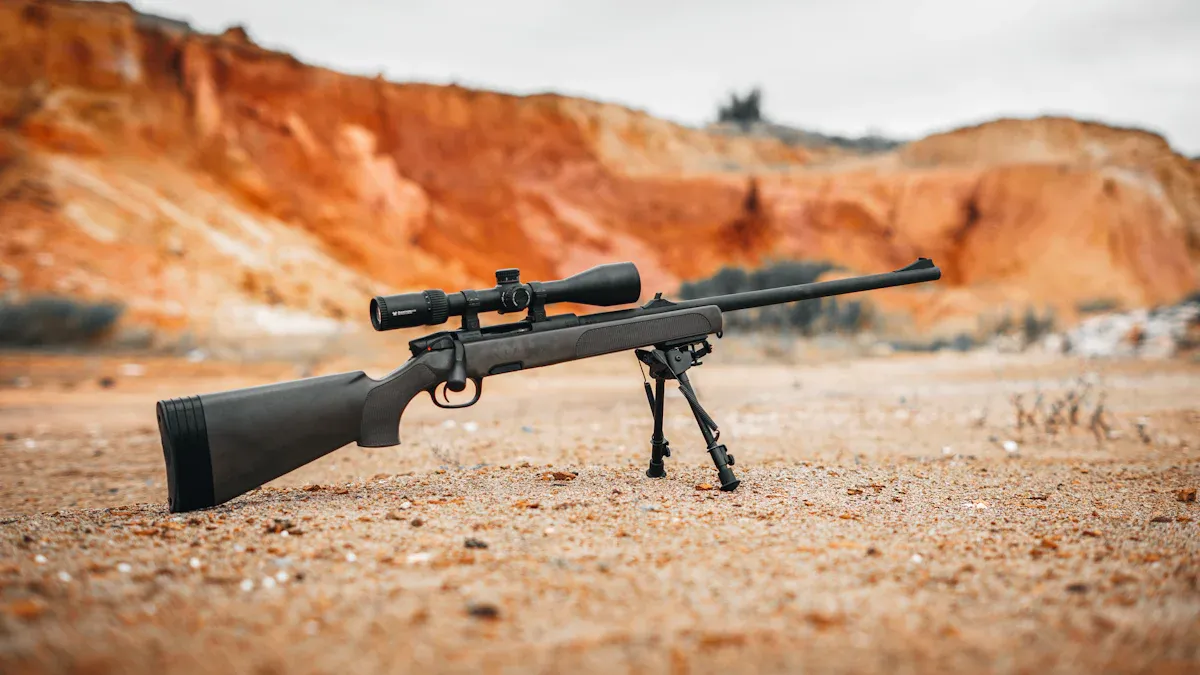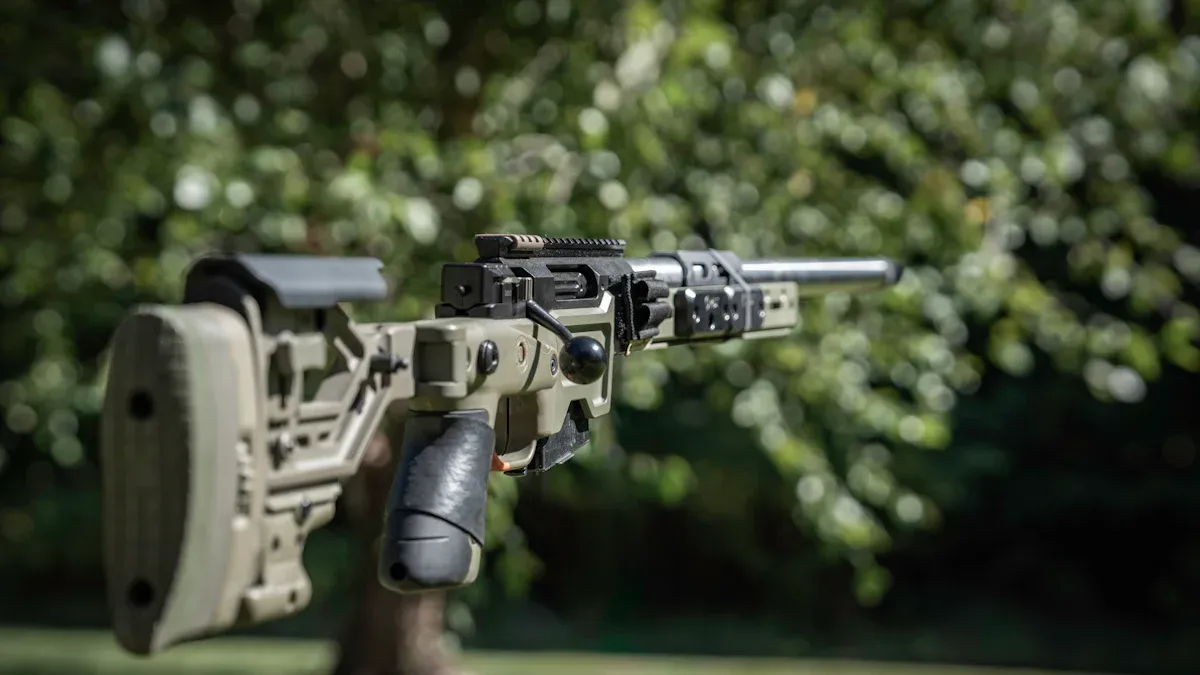
A rifle bipod enhances shooting stability, making it a valuable tool for precision shooters. It provides a solid foundation for long-range accuracy and reduces physical strain during extended sessions. However, it may not suit shooters who prioritize mobility or operate in dynamic environments. Evaluating individual needs helps determine its practicality.
Key Takeaways
- A rifle bipod helps keep the gun steady for better aim. It reduces shaking, making long-distance shots more accurate.
- A bipod lowers tiredness during long shooting times. It holds the gun’s weight, so shooters can aim better.
- Picking the right bipod depends on how you shoot and your budget. Think about what you need to find the best option for the price.
Benefits of a Rifle Bipod

Stability for Precision Shooting
A rifle bipod significantly enhances stability, providing a solid foundation for precision shooting. By minimizing movement, it allows shooters to maintain a steady aim, which is crucial for accuracy. Research highlights that larger sample sizes, such as 10-shot groups, offer a more reliable measure of a rifle’s precision. For instance, the US Army Marksmanship Unit employs three consecutive 10-shot groups to test stability. This approach demonstrates how a rifle bipod improves bullet dispersion and overall shooting performance.
Enhanced Accuracy Over Long Distances
Long-range shooting demands consistent accuracy, which a rifle bipod helps achieve. Its ability to stabilize the rifle reduces the impact of external factors like recoil and shooter fatigue. Features such as pan and tilt functionality allow for precise target alignment, even at extended ranges. A bipod’s ergonomic design, often made from durable materials like steel or aluminum, ensures comfort during prolonged use. These attributes make it an essential tool for shooters aiming to improve their long-distance accuracy.
Reduced Fatigue for Extended Shooting
Extended shooting sessions can strain a shooter’s arms and shoulders. A rifle bipod alleviates this by supporting the rifle’s weight, allowing the shooter to focus on their aim. Adjustable height options, ranging from 6 to 9 inches, provide flexibility for different shooting scenarios. This ergonomic advantage reduces physical fatigue, enabling shooters to maintain their performance over longer periods.
Versatility in Shooting Positions
A rifle bipod adapts to various shooting positions, making it a versatile accessory. Features like independently adjustable legs and ratcheting heads allow for stability on uneven surfaces. Some models, such as the Vanguard Scout, extend from under two feet to over five feet, accommodating seated and standing positions. This adaptability ensures that shooters can maintain accuracy regardless of the terrain or shooting angle.
Features of a Quality Rifle Bipod

Material and Durability
Quality rifle bipods are crafted from robust materials like aircraft-grade aluminum and carbon fiber. These materials enhance durability and ensure reliable performance in rugged conditions. Their resistance to wear and tear makes them ideal for hunters and competitive shooters who operate in extreme weather. Durable bipods maintain consistent stability, providing shooters with confidence during challenging scenarios.
- Key Features of Durable Bipods:
- Aircraft-grade aluminum offers lightweight strength.
- Carbon fiber ensures resilience against harsh environments.
- Long-lasting construction supports extended use without compromising performance.
Adjustability and Height Options
Adjustable bipods improve shooting precision by adapting to various terrains and positions. Features like rubber feet provide grip on uneven surfaces, while tilt capabilities allow for better alignment. Models such as the Harris HBRMS and MDT Ckyepod offer height adjustments ranging from 6 to 18 inches, catering to diverse shooting needs. The MDT Ckyepod stands out with extreme adjustability, extending up to 36 inches for maximum versatility.
- Performance Highlights:
- Rubber feet enhance stability on slippery or uneven ground.
- Tilt and leg adjustments accommodate different shooting angles.
- Height flexibility ensures compatibility with seated, prone, or standing positions.
Compatibility with Rifles
Top-rated bipods fit a wide range of rifle models, ensuring seamless integration for shooters. The Magpul bipod, for instance, pairs well with MOE stocks, while Harris bipods offer tailored designs for hunters and target shooters. The Valhalla bipod features a Picatinny rail attachment, making it suitable for hunting rifles. User testimonials praise the stability and adjustability of these bipods, highlighting their effectiveness in improving accuracy.
- Popular Models and Features:
- Magpul bipods excel in versatility for hunting and precision shooting.
- Harris bipods provide quick adjustments and solid construction for uneven terrain.
- Valhalla bipods enhance long-range accuracy with reliable attachments.
Weight and Portability
Lightweight bipods balance stability and portability, making them ideal for shooters who prioritize mobility. The MDT Ckye-Pods Lightweight Single Pull weighs 5 to 6 ounces less than regular models, offering stability without added bulk. The Spartan Javelin Lite Rifle Bipod, weighing under five ounces, is designed for quick deployment, making it perfect for mountain hunting or other weight-sensitive situations.
- Advantages of Lightweight Bipods:
- Reduced weight improves portability for hunters on the move.
- Compact designs allow for easy storage and transport.
- Quick deployment ensures readiness in dynamic shooting environments.
Mounting Systems
Effective mounting systems enhance the stability and usability of rifle bipods. The Mission First Tactical E-VolV Bipod Mount features a single-piece aluminum construction and dual bolts for secure attachment. This design reduces wear on the rail system and improves overall stability during use. Shooters report noticeable improvements in accuracy and reliability when firing from various firearms, validating the effectiveness of advanced mounting systems.
Drawbacks of Rifle Bipods
Added Weight to the Rifle
Adding a bipod to a rifle increases its overall weight, which can negatively impact the shooter’s experience. Hunters, in particular, often cite the additional bulk as a challenge during long treks or when navigating rugged terrain. The extra weight can reduce mobility and make the rifle less maneuverable in dynamic situations.
- Common Concerns:
- Carrying a heavier rifle becomes tiring over extended periods.
- The added bulk may hinder quick adjustments in fast-paced scenarios.
- Shooters must balance the trade-off between stability and portability.
Limited Use in Dynamic Scenarios
While rifle bipods excel in stationary shooting, they fall short in dynamic environments. Shooters engaged in activities like competitive 3-gun matches or tactical training often find bipods cumbersome. The time required to deploy and adjust the bipod can slow down target acquisition. Additionally, the fixed position of the bipod limits flexibility, making it less suitable for fast-moving or unpredictable situations.
Cost of High-Quality Models
High-quality rifle bipods often come with a steep price tag. For example, the Magpul bipod, priced at $104.45, offers excellent features like durability and multiple mounting options. However, premium models like the Atlas bipod, which provide superior long-term value, require a higher upfront investment. In contrast, budget-friendly options such as the Harris bipod start at around $90 but may incur additional costs for accessories, raising the total to $160-$200. Shooters must weigh the benefits against their budget to determine the best option.
- Price Comparisons:
- Magpul bipod: $104.45, offering competitive features.
- Harris bipod: $90 base price, with potential accessory costs.
- Atlas bipod: Higher cost but better long-term value.
Learning Curve for Setup
Using a rifle bipod effectively requires practice and familiarity. Beginners may struggle with proper setup, including adjusting the height, securing the mounting system, and aligning the rifle. Incorrect setup can lead to instability, negating the bipod’s benefits. Shooters must invest time in learning how to deploy and use the bipod efficiently, which can be a barrier for those new to the accessory.
Tip: Practicing with the bipod in controlled environments can help shooters master its setup and operation, ensuring optimal performance in the field.
Choosing the Right Rifle Bipod
Assessing Your Shooting Style
Selecting the right rifle bipod depends heavily on understanding your shooting style. Precision shooters often prefer models like the Atlas bipod, which offers lightweight construction and compact design for stability in various positions. For those who frequently shoot at different angles, bipods with adjustable legs, such as the Odin Works Prizm, provide the necessary versatility. Shooters engaged in dynamic scenarios may find the Harris bipod suitable due to its quick deployment and durable design.
| Bipod Model | Percentage of Top Shooters | Key Features |
|---|---|---|
| Harris Bipod | 45% | Quick deployment, durable design, easy height adjustments |
| Atlas Bipod | 38% | Versatile features, stability in various positions |
Tip: Shooters should evaluate their typical shooting conditions and frequency to determine the most compatible bipod features.
Budget Considerations
Budget plays a crucial role in choosing a rifle bipod. High-end models like the Atlas bipod deliver exceptional stability and adjustability, making them ideal for precision shooting. However, they come with a higher price tag. For casual users, budget-friendly options like the Leapers UTG or Caldwell bipods offer basic functionality at a lower cost.
| Bipod Brand | Purpose | Performance | Price Range |
|---|---|---|---|
| Atlas | Precision Shooting | High stability, adjustable | High |
| Leapers UTG | Casual Use | Adequate for hunting, range | Low |
| Caldwell | Casual Use | Basic functionality | Low |
Shooters should weigh their needs against their budget to find the best balance between cost and performance.
Alternatives for Stability
While a rifle bipod is a popular choice for stability, alternatives exist. Shooting bags provide a stable base but lack adjustability and portability. Bench rests offer solid construction but are less versatile and slower to adjust. These options may suit specific scenarios but often fall short of the adaptability and convenience provided by a rifle bipod.
- Shooting Bags: Heavy and non-adjustable, limiting their flexibility.
- Bench Rests: Sturdy but lack the quick adjustments and versatility of bipods.
Note: Alternatives may work for stationary shooting but rarely match the efficiency of a well-designed bipod.
Rifle bipods enhance shooting stability and accuracy, especially in long-range or stationary scenarios. However, they may not suit shooters who prioritize mobility or dynamic environments. Evaluating the benefits, features, and drawbacks helps shooters determine if this accessory aligns with their specific needs and shooting style.
Post time: Apr-03-2025
